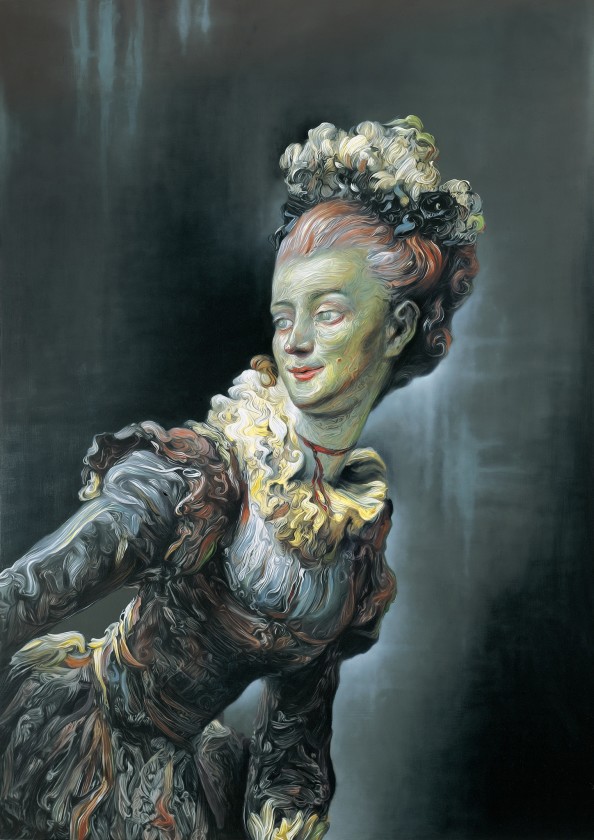SHE: Picturing women at the turn of the 21st century: Bell Gallery and Cohen Gallery, Granoff Center Providence, Rhode Island, USA
Spanning a period of twenty-four years—from 1989 to 2013—SHE presents a broad-ranging selection of contemporary representations of women.
The exhibition, which is drawn from a private collection, includes works by eleven of the most highly acclaimed artists working today. Within these paintings, sculpture, and videos are both convergences and divergences in style, concept, and intent. Some artists, notably Jenny Saville and Cindy Sherman, examine the position of women in society from an overtly feminist viewpoint. Others, such as Lisa Yuskavage and Rebecca Warren, wrest control of explicit sexual imagery from the hands of men. Yet others, such as George Condo, Glenn Brown, and Jeff Koons, show little to no concern with the politics of gender; instead they continue on the art historical path of depicting women as objects of beauty or desire, albeit to differing and individual ends.
Jenny Saville’s massive and masterful paintings of obese women challenge conventional ideals of female beauty, while Cindy Sherman’s History Paintings expand her critique of representations of femininity into the art historical past as she reworks portraits by Rembrandt, David, and Fragonard (included here). Candice Breitz focuses on Hollywood’s portrayal of motherhood. Compiling clips from recent films in her video installation Mother, Breitz presents a less-than-flattering picture of the exasperation, insecurity, self-blame, and anxiety that these filmic women express about their maternal abilities.
John Currin and Lisa Yuskavage unapologetically embrace and exaggerate images made by and for men, from advertising to pornography. While Currin admits to a chauvinistic fascination, Yuskavage attempts to take possession of this previously male venue. Similarly, Rebecca Warren’s sculpture L channels the comic imagery of R. Crumb’s outrageously sexualized women. Working in unfired clay and bronze, Warren has developed a signature style of joyous and exuberant lumpen figures (often presented on light pink plinths) that have transformed her precedents from Crumb to Degas and Rodin.
The exhibition’s discourse on gender is compounded by issues of race in the works of Chris Ofili and Yayoi Kusama. Reversing the spelling of “a negro,” Ofili created Orgena, an icon of African beauty related to his Afro Muses series. Confronting racial and gender discrimination in 1950s New York, Yayoi Kusama embarked upon her conceptual exploration of self-obliteration. She is represented here by a lesser-known painted self-portrait from a series that dates back to 1982.
Women are frequent subjects in George Condo’s work (evidenced by his 2005 exhibitionGeorge Condo: One Hundred Women organized by the Museum der Moderne Salzburg and Kunsthalle Bielefeld). However, Condo is not particularly interest in feminism. The same can be said of Glenn Brown. They are both, instead, deeply concerned with painting—the simple and not-so-simple application of pigment to canvas. Applying their idiosyncratic and highly identifiable styles to images of women, they parse the satirical, the humorous, and the grotesque.
For Jeff Koons, like Condo and Brown, “woman as subject” is secondary to formal concerns. His Gazing Ball (Ariadne) is a spectacular sculpture—a juxtaposition of a Classical figure reproduced in gleaming white plaster and a deep blue, reflective, gazing ball. In other works from the Gazing Ball series, Koons combines his gazing balls with plaster mailboxes, birdbaths, and snowmen. For Koons, women and mailboxes are the same; both are fodder for his world of Pop—no more, no less.
Each of these artists responds to the representation and figuration of women in their own way. The intentions and interpretations range from feminist critiques to incidental observations — from feminism as critical subject to woman as compositional subject.
Glenn Brown will be showing the work Filth from 2004.
http://www.brown.edu/campus-life/arts/bell-gallery/exhibitions/she-picturing-women-turn-21st-century
----------
In addition, Glenn gave a lecture on
Wednesday, November 19, 2014 at 5:30pm
LIST ART AUDITORIUM
Providence, Rhode Island USA
http://www.brown.edu/campus-life/arts/bell-gallery/events/2014/11/19/artist-talk-glenn-brown

